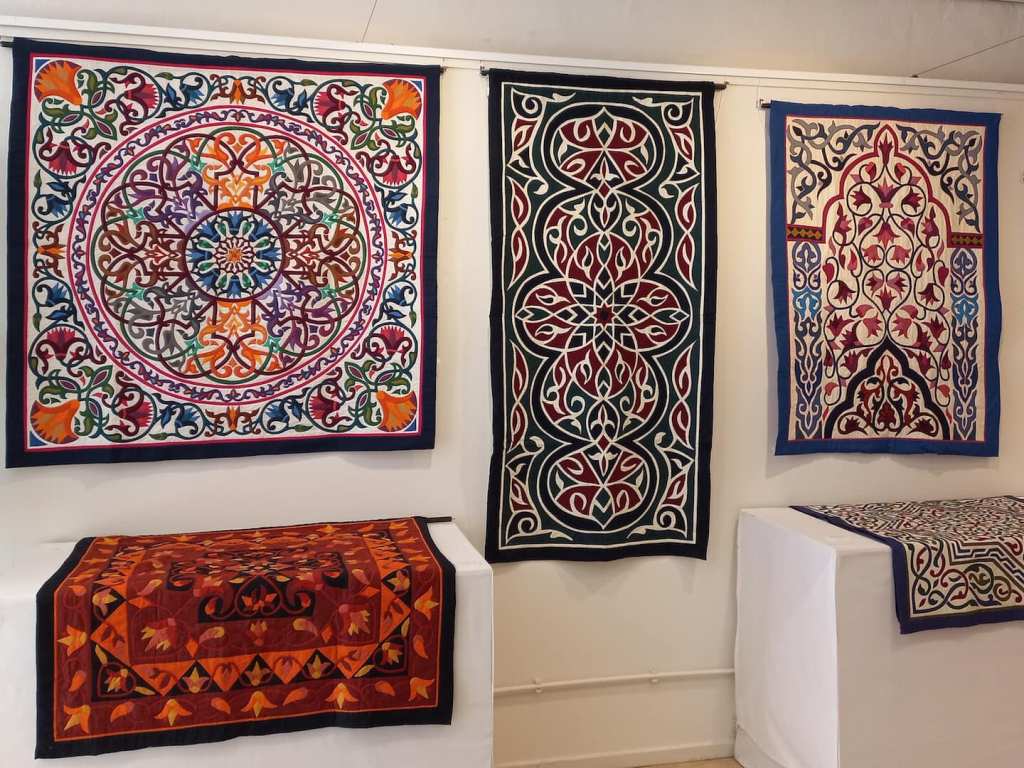
IMPORTANT – This blog contains several videos. If you subscribe via email you may need to click on the blog title to take you to our WordPress site to ensure you can view them.
******************************
The 13th International Congress of Egyptologists is currently taking place in Leiden (Netherlands). To complement this the Textile Research Centre has organised a pop-up exhibition around the colourful textiles (known as khayamiya) from the Street of the Tentmakers in Cairo.
“It is based on the TRC’s collection of appliqués that include geometric, naturalistic, textual as well as modern story forms.
They are used as tent decorations, room dividers, as well as wall hangings and cushions covers. Background information and many other examples of appliqués from the Street can be seen in TRC’s online exhibition. [There are lots of excellent images and much more information at this link].
There is also a mini-exhibition of other Egyptian textiles from the TRC Collection. These historic textiles date from about the fourth to the tenth century. They include various types of woven textiles (mostly tapestries) in wool and linen.” – TRC website
This exhibition will run until mid-September.

Dr Sam Bowker has done a huge amount of research on this subject and co-authored The Tentmakers of Cairo: Egypt’s Medieval and Modern Applique Craft with Seif El Rashidi.
This is a link to a talk he gave about this textile tradition a couple of years ago.
******************************
A new exhibition called Textile Welten (Textile Worlds) opened recently at the Pinakothek der Moderne museum in Munich.
“Textiles shape human existence, they paved the way for industrial design, provided important inspiration for the development of Modernism in art, and today reflect the current topics of environment and sustainability and are sure to spur innovation in spatial design and architecture.
Die Neue Sammlung possesses important textiles and fabrics from the mid-19th century through to the present day. They not only embody the development of textile production as a craft and an industry but also demonstrate how the lines dividing art and design are gradually becoming blurred in this field. After all, textiles are especially suited to exploring the connection between material and aesthetics.” – Museum website

The exhibition runs until 3 October 2023 and you can find out more about it here.
Ingo Barlovic has written a review of the exhibition, and provided many more images (especially of the molas) here.
******************************
Hopefully many of you attended the talk David and I recently gave on Sumbanese textiles for the George Washington University and the Textile Museum. For those that missed it, the recording of this talk is now available online.
One of the textiles we talked about was the lau pahikung – a sarong decorated using the supplementary warp technique. This photo is of Rambu Ata Pau, a Sumbanese friend who was a skilful pahikung weaver and passionate about Sumbanese culture who sadly died this week. In the photo she is wearing a lau pahikung and has a hinggi draped over her shoulders. You can find out more about the pahikung technique here.

******************************
I met Judy Frater in Kutch many years ago and admire her dedication to the crafts of that area.
“For decades, anthropologists have discussed the “great” and “little” traditions of India as a way to distinguish between established, mainstream cultural practices in urban areas (“the great”) and local customs and rituals found in rural spaces (“the little”). In fact, the dynamic cultural flow between the city and village, elite and folk has invigorated India from ancient times until the present. Drawing on 50 years of deep connection to India and its rich textile traditions, Judy Frater shows how folk embroidery traditions of Kutch in western India have absorbed and interpreted popular trends in urban culture to create distinctive, evolving languages of needle and thread from the 20th century to the present.” – Textile Center
Here is the link to Judy’s talk on the Folk Embroideries of Kutch.
******************************